Service Firms Strategy Guide
By Stylesjl
The addition of Service firms to Capitalism Lab has introduced a new method to further expand your business into the realm of providing food and beverage services such as Fast Food, Coffee and more.
This guide will provide you information on how to incorporate services into your business in order to maximise your profits.
Service Firm Basics
Let’s begin by explaining how Service Firms work:
A Service Firm is both a Manufacturing and Retail firm rolled into one. The Service firm will take basic products such as Tomatoes, Burger Patties and Burger Buns and produce a product, such as a Hamburger (a process similar to how a factory works). The product is then sold directly to the customers (similar to how a retail store works).
An example of this process is shown in the picture below:
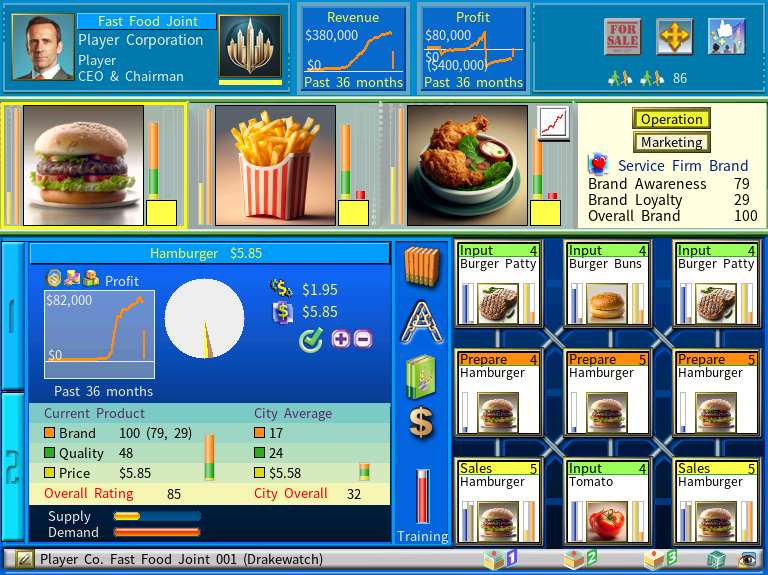
Here the Fast Food Joint will buy the ingredients (i.e. a Purchasing Unit), prepare those ingredients (i.e. a Manufacturing Unit) and then sell them via a Sales Unit.
There are a few important differences from the standard retail/factory firms however:
– A Service firm does not have a Brand Rating for the individual products, but instead the Brand Rating is for the type of Service Firm as a whole, for example a Brand Rating for the Fast Food Joint, another rating for the Coffee Shop, etc.
– You cannot sell service products to other companies, everything you prepare must be sold in the same firm.
– Some of the products used as ingredients in Service firms can also be sold in Retail stores, such as Burger Patties or Burger Buns, which provides some useful opportunities to combine your service and retail firms together. More on this will be explained in the next section.
We now have a basic idea of how service firms work. We should now take a look at the types of Service Firms available. There are four basic types of Service Firms, with three products that can be sold in each store.
– Cake Shop: Sells Chocolate Cake, Lemon Tart and Strawberry Cake.
– Coffee Shop: Sells Caffe Americano, Cappuccino, and Latte.
– Fast Food Joint: Sells Hamburgers, French fries and Fried Chicken.
– Pizzeria: Sells Beef Pizza, Chicken Pizza, and Parma Pizza.
Each of these firms has different ingredient requirements to make the products they sell; these different requirements will have an effect on the strategy you should employ as some ingredients are easier to obtain than others.
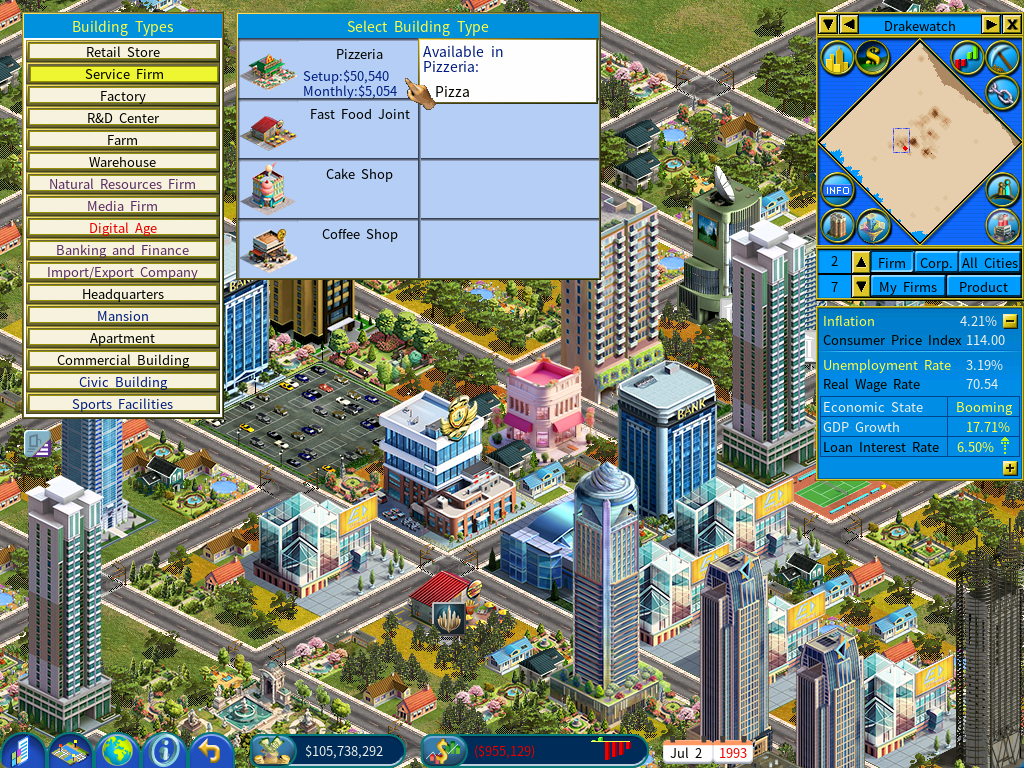
Service Firms Strategies
In general there are two broad approaches you can take with Service Firms:
– Starting with service firms immediately and using the products to expand into other industries.
– Starting another business first such as Food/Beverage/Snacks and then using the products as a base to expand into Service Firms.
In general I personally prefer the second approach for reasons that will be explained below, however both strategies are viable methods of making money.
Service Firm Start Strategy
This strategy involves setting up and establishing Service firms without establishing your business presence in other industries first. This can be a tricky approach as services are highly competitive industries where many competitors can jump in at a very low cost, so it is important to get an edge over your competition quickly and to then maintain it in the longer term.
The most important decision is to determine what service firm type and products you are going to start with, as some of the ingredients required will be more expensive to produce than others.
For example to create a Hamburger from a Fast Food Joint you will need the following:
– A farm producing Tomatoes, Frozen Beef and Wheat.
– A factory that processes the Frozen Beef into Burger Patties and two more factories to convert the Wheat into Flour and the Flour into Burger Buns, for a total of 3 factories.
That is quite a lot of expenditure right out the gate! The other products such as Fried Chicken and French Fries also require their own unique, non-overlapping ingredients, adding even greater expenses.
This makes Fast Food a tough start unless you have quite a lot of money to burn or an existing food industry (more on this in the Food Industry Start section).
The same problem likewise appears to a lesser extent for Pizza (Olives, Frozen Beef/Chicken, Tomatoes and Flour) and Cakes (Flour, Eggs, Lemon, Cocoa and Strawberry).
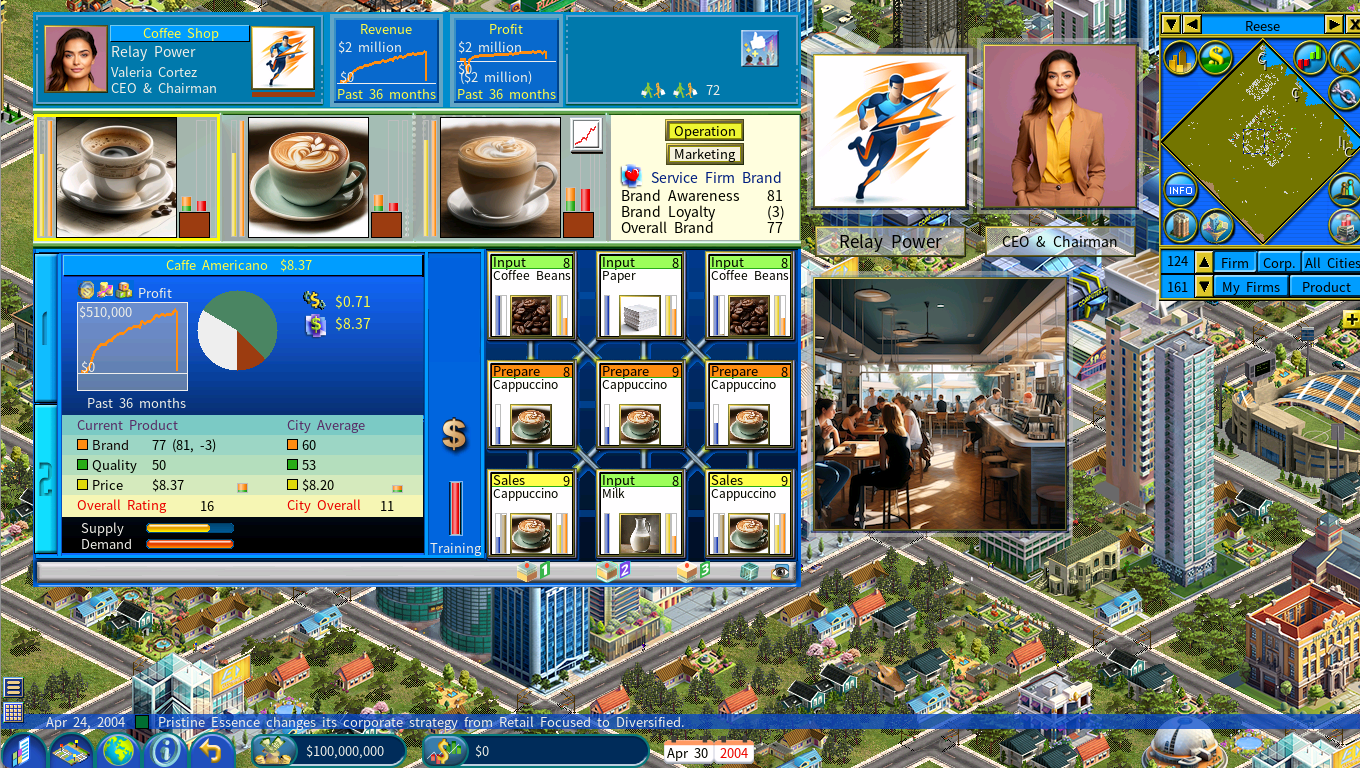
For this reason therefore it is best to start with Coffee. Coffee is much easier to start with as it only requires the following:
Coffee Beans
Milk
Sugar (for one of the Coffee types)
Paper (for all except one of the Coffee types)
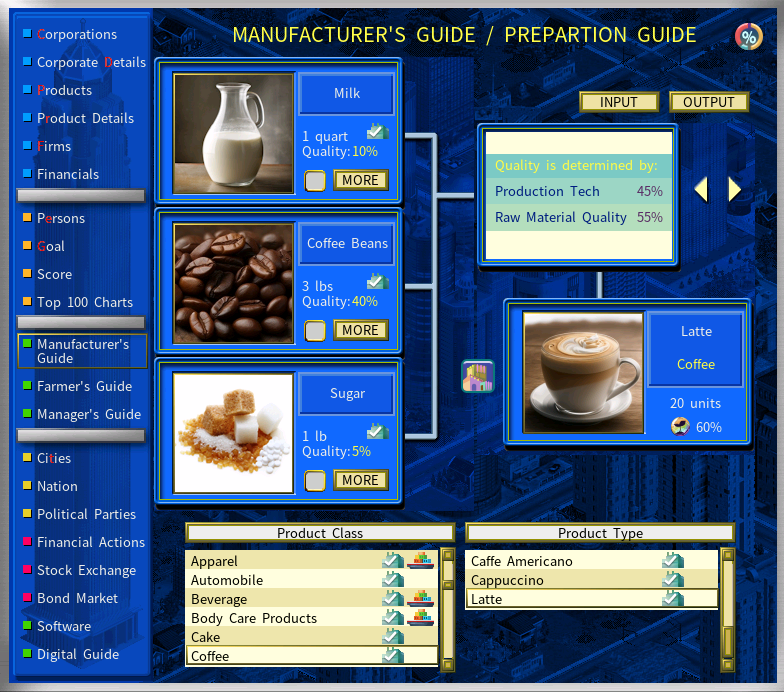
All of these are cheaper and easier to obtain at the start of the game with one potential exception (Paper). It is for this reason that Coffee is the best Service firm to start with on a low budget.
When you start the game the following general steps should be taken:
1) Build a medium sized farm; try to build it reasonably close to the city to reduce freight costs.
2) Inside the farm you should arrange it so that it will produce Milk, Coffee Beans and Sugar in the same farm (since it is important to save as much as you can during the early stages). Set the training level to the maximum to ensure that the raw material quality is raised to 100%. An example of what this layout might look like is pictured below:
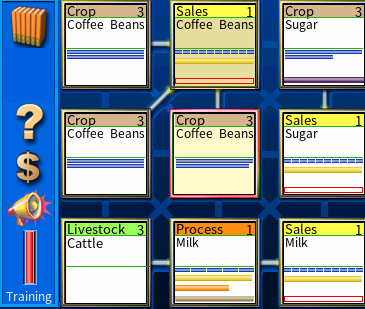
3) Find a location in the city where the land is available for purchase and the traffic is very high, the higher the traffic, the better. Shopping Malls are another excellent location to place your Coffee Shops as the up-front costs are very low and the malls will very likely increase traffic over time as more companies add their stores to it.
Build your Coffee Shop and begin the process of selling coffee. If your game settings allow it try to add two additional floors and sell each coffee type on each floor:
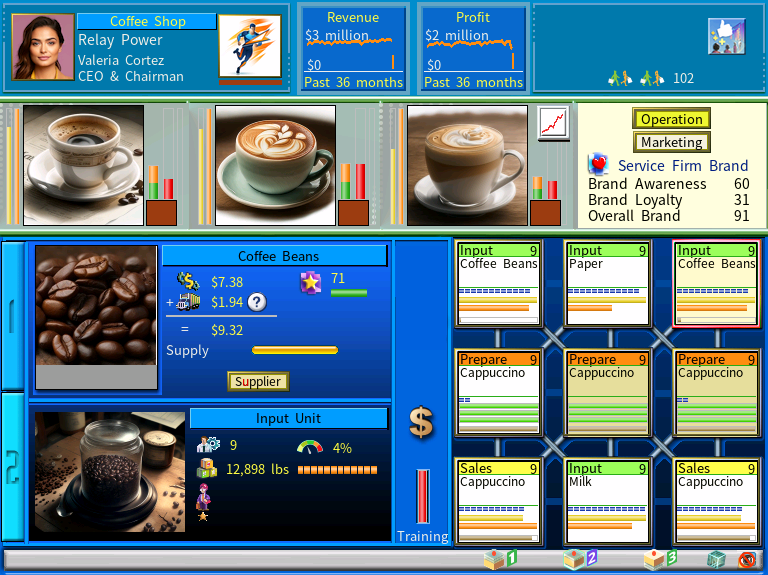
4) You will note in the above example that some of your coffee types require another resource: Paper. This resource is very expensive to produce at the start of the game as you will need a very expensive Logging Camp and Paper Factory. As a result you should buy this resource from another company or a seaport until you can make enough money to afford your own Paper supply chain. This will not be a large financial burden as paper is cheap and Coffee shops use very little paper.
If for some reason no-one else is producing Paper then the only Coffee type you will be able to sell will be Lattes, which will make the Coffee shop less profitable. In this case you may need to consider starting with a different service firm such as Cakes or Pizza (no Paper required for either).
5) Once your Coffee Shop is established you should start an advertising campaign to improve the brand and make your coffee more popular. Remember that only one shop needs to do the advertising, the brand will apply to all Coffee Shops.
6) You may need to initially lower your prices to attract new customers to your shop, but once the quality and brand improve you can raise them again.
7) Add more shops around the city; use the Duplicate Firm button to make this process easier. Do not add Coffee Shops too close to each other (unless the existing shops are unable to keep up with demand) or in low traffic areas as this will waste money.
8) By this point your Coffee Shop should start generating a nice return. Use this money to continue adding new stores and if necessary you may need to build more productive farms to keep up with the demand, be mindful that the Coffee and Sugar crops are seasonal in nature, so it is easily possible to deplete your entire inventory unexpectedly if you don’t pay attention to supply levels.
9) You can also optionally also set up an R&D Centre to research higher quality coffee, if your budget allows it. However you should take note that for all types of Coffee the Quality forms 35% of the Overall rating and for all of the Coffee types, the raw materials are 55% of the quality (except Caffe Americano, where it is 50%), so for this reason R&D is not that important in the early game, but as competitors enter the market, having an R&D edge can help you stay one step ahead.
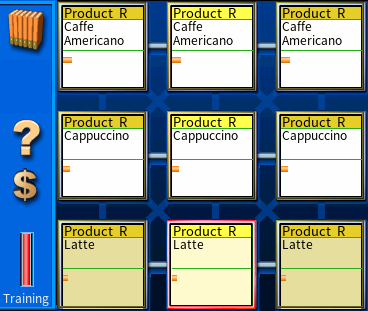
10) Now that you are making several million in profit from Coffee it is time to expand into other services. My recommendation for the next service type would be Pizza. The reason for choosing Pizza is that it is a very popular item that sells quite well and it also requires relatively few ingredients to start with (Flour, Frozen Beef/Chicken, Olives, Tomatoes and Parma Ham).
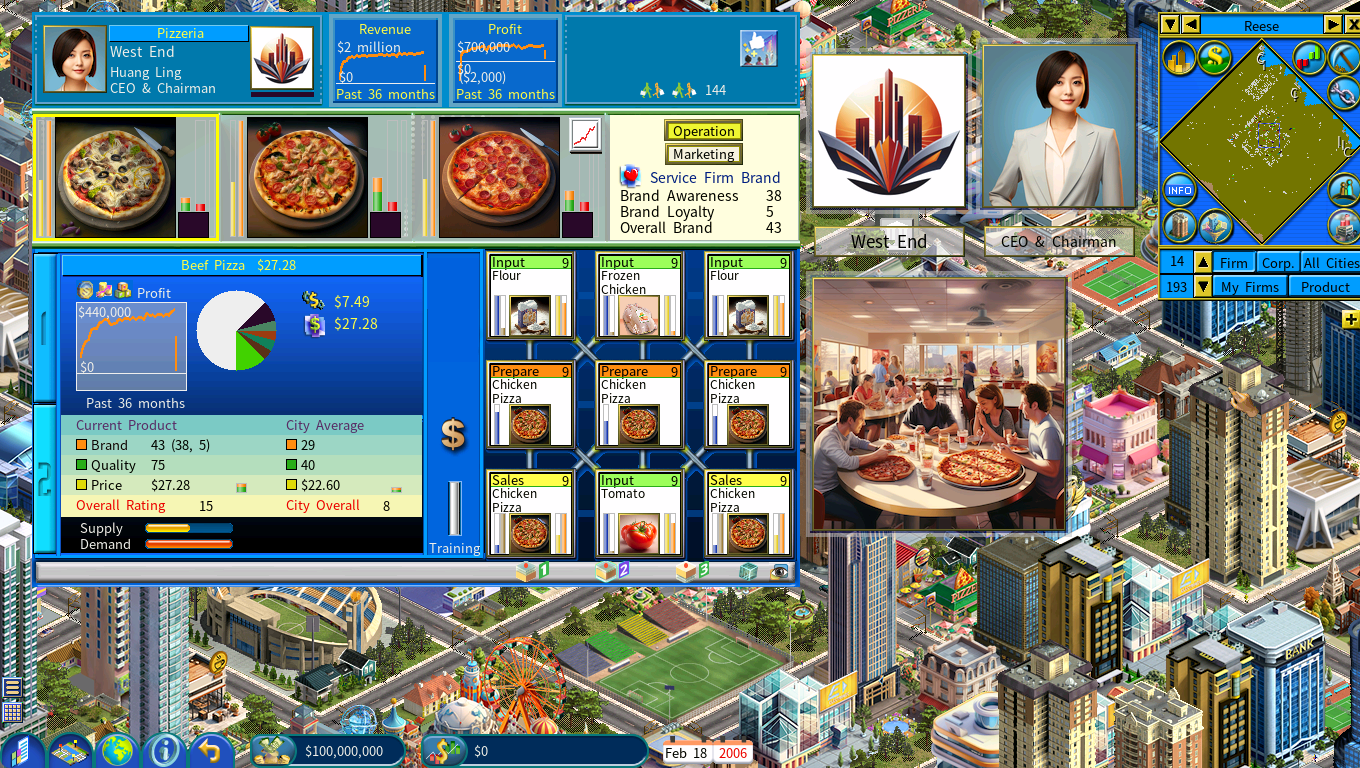
11) Prepare your farming/factory setup as follows:
– Build a medium farm and produce Frozen Beef/Chicken/Pork in the same farm.
– Build another medium farm and produce Tomatoes and Olives (Tomatoes should have more crop units than the Olives as Tomatoes will be in greater overall demand).
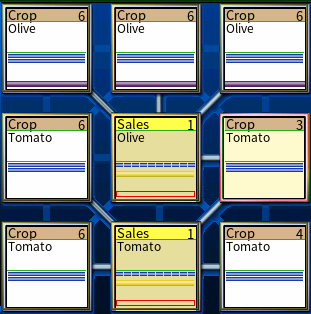
– Build a small/medium factory and use it to create Parma Ham from the Frozen Pork.
– Build a medium farm and dedicate it to growing Wheat only.
– Build a large sized Flour factory.
– Optionally create an R&D Centre to research for all of the Pizza Types as well as the Flour and Parma Ham. Much like the Coffee however, R&D is only 50% of the quality for all Pizza Types and quality is only 35% of the overall rating.
12) Start building Pizzerias in high traffic locations, preferably next to the Coffee Shops to get the traffic boost from having service/retail firms close by, which will benefit both firms. Be sure to advertise and potentially cut initial prices to get the pizzas out the door.
13) Once you are making lots of money from Pizzas you should then expand into Cakes and Fast Food, using similar techniques described above. In the case of all Cake types and Fried Chicken the Flour requirements will be quite high compared to everything else, which is why it is very important to have a large Flour factory and a large amount of high quality Wheat to supply it.
14) By this point you will most likely be making tens of millions each year in profit, the next logical step would be to use the surplus production from your farms to expand into Food/Beverages and Snacks. For example you can sell the Burger Buns, Burger Patties, Eggs, Frozen Beef/Pork/Chicken and Parma Ham used by your Service firms directly in the Supermarkets, further boosting your profits. In fact it is best to expand your food business in parallel to your service business, adding new products as you go.
15) You can also create new products to sell into the Supermarkets by adding a few new raw materials, for example the Lemons used for Lemon Tarts can be used to make Citric Acid and the Citric Acid can be made into Yogurt, likewise adding Glass to your existing Milk supply can get you Bottled Milk and Olives can be made into Canned Olives. Check out the Manufacturer’s Guide for the full list of possibilities.
16) Once you have fully conquered the Food/Beverage/Snack industry you will be well on your way to expanding in other industries. Some further ways you could improve your service firms at this point would be to:
– Vertically integrate the entire supply chain, such as by producing your own Paper and other raw materials needed in Food (Glass, Aluminium, etc.).
– Control Media/Internet firms so you can advertise effectively for free.
– Strategically place your various retail and service firms together so they all boost each other’s traffic.
– Spend lots of money on full R&D to stay well ahead of the competition.
– If you have the money, buy out your competitors and try to establish a monopoly on Food and Services.
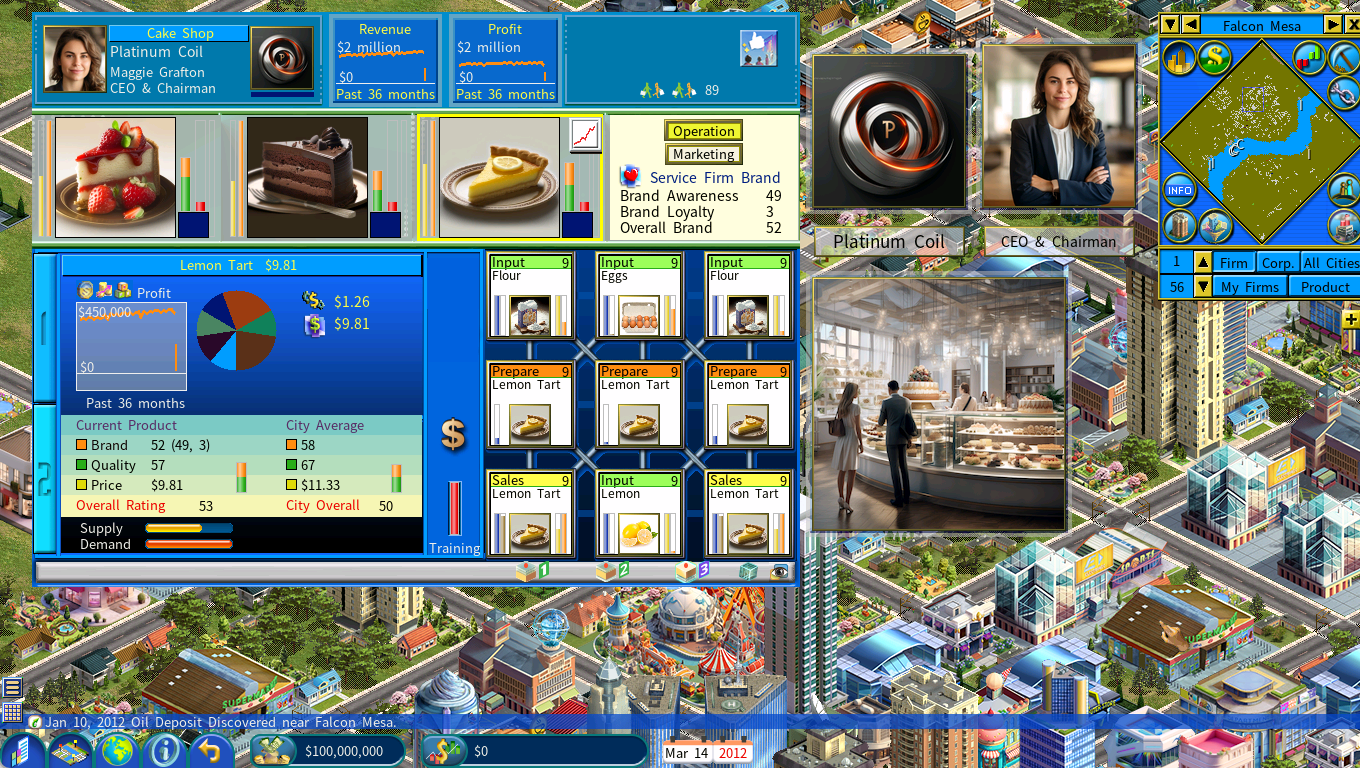
Food Industry Start Strategy
There is an alternative approach to starting in the Service Industry at the start of the game and that is to start in another industry and use the profits and existing supply chains to give you an advantage when you decide to move into services.
The advantages behind this approach are that you will have ready access to many advantages that your competitors may lack such as an existing supply chain, access to high quality food ingredients and a large capital base to absorb temporary losses while you catch up.
The disadvantages are that you will be battling established competitors that will likely have an R&D edge over you as well as some ingredient quality advantages (such as for Coffee Beans, Tomatoes or Potatoes).
When you start the game the following general steps should be taken:
1) Begin your food industry with Livestock Products, Frozen Pork/Beef/Lamb/Chicken as well as Eggs. In addition build two factories to produce Parma Ham and Burger Patties. Sell all of these products in the Supermarkets and try to raise the quality as much as possible via training on the farms. Consider adding Export Companies as well so that you can sell your farm products outside of the city. More on how to use the Export Companies in this guide: https://www.capitalismlab.com/export-strategy/
2) Once you start generating profits from these items you can start moving into more sophisticated food items such as creating Flour for Burger Buns, Olives for Canned Olives as well as other products like Milk, Sugar or Cocoa. If you have access to certain raw materials from other companies or seaports such as Aluminium or Glass you can also create other food products such as Bottled Milk or Canned Soup. Try to add as many different Supermarket products as possible with the fewest different inputs as possible in order to save money.
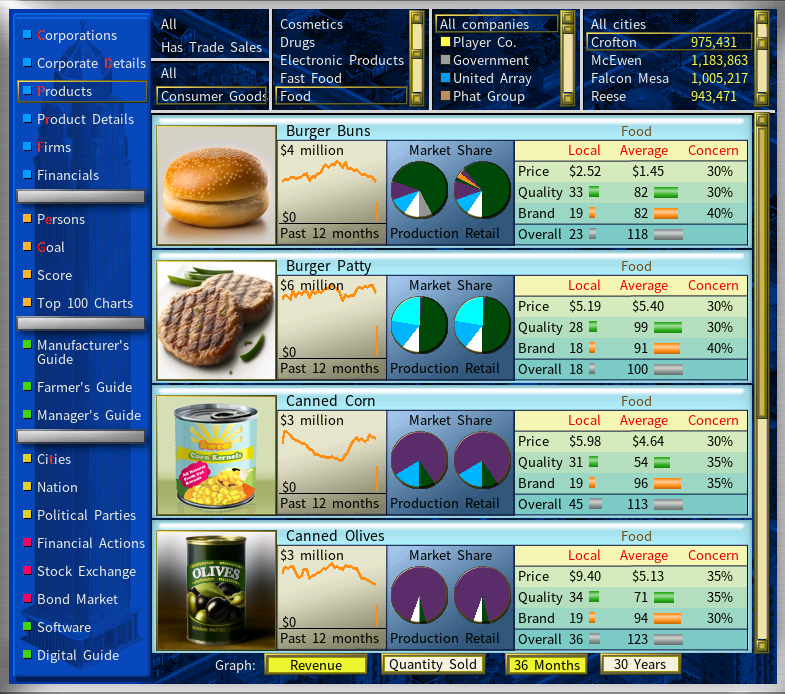
3) You don’t need to produce all of the Food/Beverage/Snack types before you can move into Services, you just need enough to create most of the required supply chain. For example if you are producing Frozen Chicken, Flour, Burger Buns and Burger Patties then the next logical step would be to start opening Fast Food Joints as you can already start producing Fried Chicken right away and if you start growing Tomatoes then Hamburgers will be available as well. French Fries can be skipped until later if your budget is too tight for Potatoes.
4) Once you have started growing tomatoes you will also notice that you can create Pizzas as well, so this is the next logical target for expansion. By this point you will be producing nearly half of all of the Service Industry products and most of the Food items but none of the Snacks or Beverages.
In effect your product list will at this stage look like:
Food: All Livestock Products, Burger Patties/Buns, Canned Olives.
Fast Food: Fried Chicken, Hamburgers.
Pizza: All Pizza types (Chicken, Beef and Parma).
Alternatively if you want a slightly leaner operation, skip producing Eggs (until you are ready to create Cakes) and Frozen Lamb (no other products are made from this). Once you get enough money you should start producing these items however to complete the supply chain.
5) As you gradually expand your food business think about further expanding the Services in parallel to the new food items you are creating, for example if you create a Cereal Bar this can lead to Strawberry Cakes in the Cake Shop as you will already have the Flour and Eggs required. Likewise if you have a Bottled Milk business going then this may be a good opportunity to expand into Coffee (as Coffee needs Milk).
6) It should be noted that for Service firms such as Cakes and Coffee you may find that there is a great deal of established competition by the time you are able to get into these industries. In the case of Coffee this problem will be further complicated by the problem of low quality Coffee Beans compared to your competition. This can be overcome to some extent by spending aggressively on advertising and offering cut-rate prices until you can catch up in terms of quality.
7) Once you have fully conquered the Services along with the Food/Beverage/Snack industry you will be well on your way to expanding in other industries. The same advice as noted in the previous section applies in this case as well.
Other Strategies and Notes
You may find some of these ideas useful as part of your broader Service Firms strategy:
Subsidiaries
– In the Subsidiary DLC you can control companies that will expand into other industries on your behalf. When you are choosing which industries your subsidiary is allowed to expand into it would be useful to allow them only the following:
Beverages
Cakes
Coffee
Food
Fast Food
Pizza
Snacks
